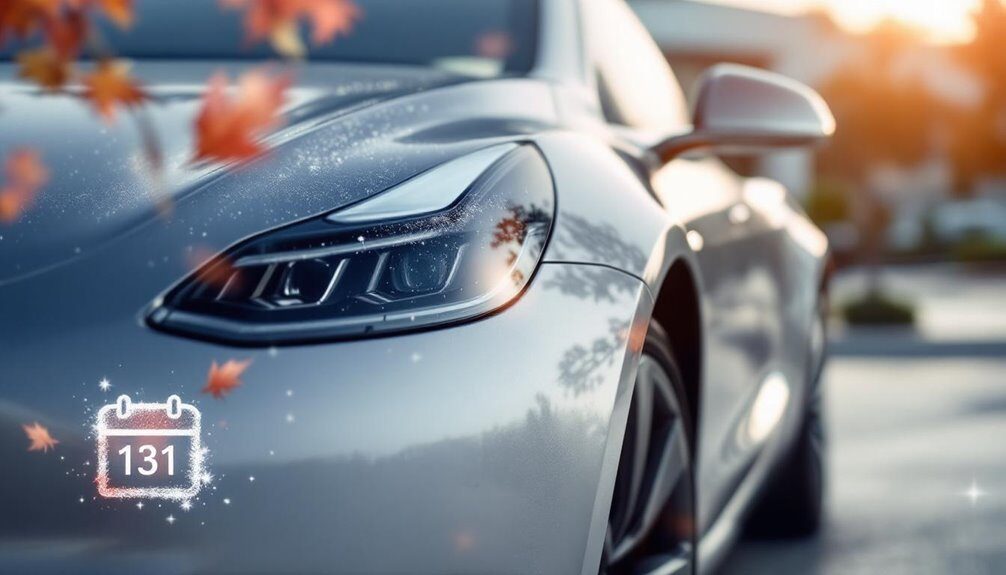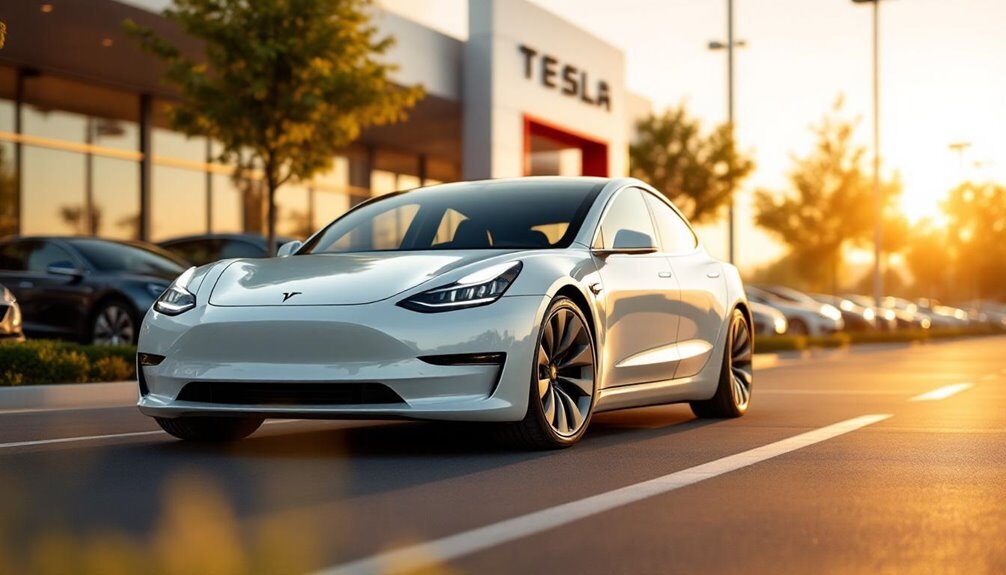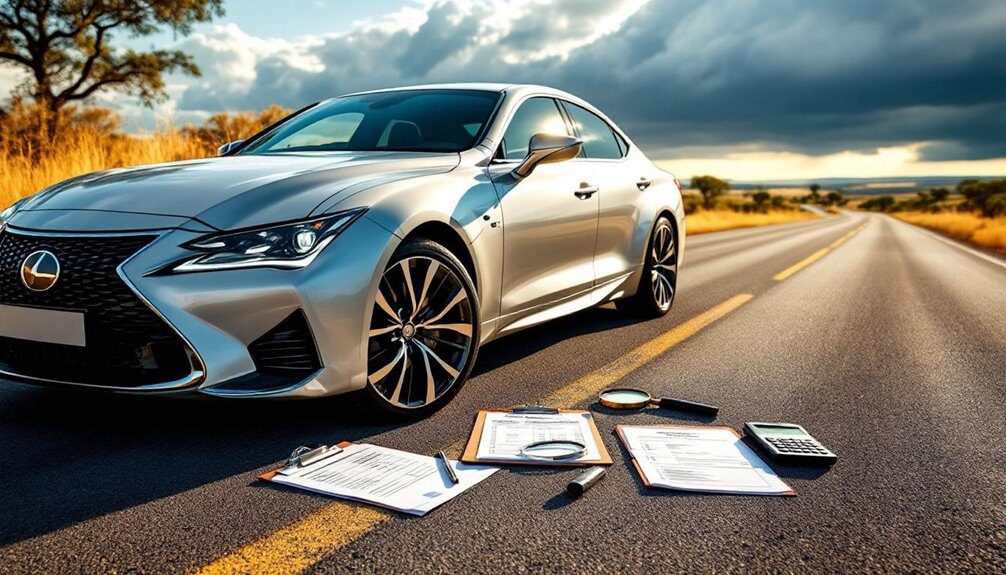You’re looking at hatchbacks like the Toyota Vitz (R178,800) and Suzuki Swift (R219,900) for pure affordability. Crossovers? The Toyota Urban Cruiser crushes it around R300k–R400k. Saloons stay tight under R230,000 with the Proton Saga and Suzuki DZire. Most run 1.0–1.5-litre engines sipping fuel at 4.4–5.7 L/100km. Manual’s cheaper; automatics sell faster. You’ll find ABS and airbags standard now. Chinese brands are muscling in with extended warranties, reshaping what you can actually afford.
The Most Budget-Friendly Hatchbacks for New Buyers
You’re staring at the used car listings and wondering if you can actually afford something decent. Good news: budget hatchbacks exist, and they won’t drain your wallet entirely.
Budget hatchbacks exist, and they won’t drain your wallet entirely—real, achievable options for first-time car buyers.
The Toyota Vitz kicks off around R178,800—basically pocket change in car terms. It’s compact, sips fuel at 4.2 L/100 km, and parts won’t murder your bank account. The Suzuki Swift lands near R219,900 and delivers reliable handling without breaking the bank on maintenance. You can also opt for subscription services like Kinto One to spread costs over time instead of paying upfront.
Then there’s the Volkswagen Polo Vivo, starting at R271,900. Yeah, it costs more, but 2,549 units sold in January 2025 proves people trust it. Locally made means cheaper servicing. The Polo Vivo’s 1.4-litre engine produces 130 N·m of torque, giving it a responsive feel that outperforms rivals in its class. At Autobahn Motors, our experienced team can help guide you through selecting the right budget hatchback for your needs and budget.
Want something quirky? The Suzuki S-Presso sits around R185,000 with SUV vibes and 4.4 L/100 km efficiency. For first-time buyers, routine maintenance on these vehicles keeps them running reliably without unexpected costs.
These aren’t dreams. They’re real, achievable options for first-time buyers who actually want to keep their cars running.
Entry-Level Crossovers Worth Considering
Hatchbacks are fun, sure. But here’s the thing—crossovers are where it’s at if you want that raised ride height and SUV vibes without breaking the bank.
You’re looking at the Toyota Urban Cruiser 1.5 XR Auto (around R300k–R400k), which just snagged Best Budget Crossover at the 2025 CarsAwards. There’s also the Haval Jolion starting at roughly R342,950, or the Renault Kiger if you’re chasing South Africa’s cheapest option. The Kia Sonet and Suzuki Fronx round out solid choices. The Urban Cruiser’s 1.5-litre engine delivers 77 kW of power whilst maintaining a claimed fuel consumption of just 6.1 L/100 km.
These things come packed with safety essentials—ABS, ESC, four airbags minimum—plus air conditioning and decent fuel economy. You get practicality, light off-road credentials, and modern styling. If you’re considering used alternatives, dealers like Autobahn Auto offer nationwide vehicle delivery alongside competitive financing options. For first-time buyers seeking personalised guidance, comprehensive automotive care providers in your area can help match the right vehicle to your needs. They’re dependable daily drivers that don’t feel like total compromises.
Compact Saloons Under R230,000
If you’re serious about keeping things lean—like, genuinely broke-student lean—compact saloons under R230k are where the real deals hide. You’ve got options. Real options.
| Model | Price | Engine |
|---|---|---|
| Proton Saga | R209,900 | 1.3L petrol |
| Suzuki DZire | R217,900 | 1.2L petrol |
| Hyundai Grand i10 | R224,900 | 1.0L petrol |
The Proton Saga kicks things off at R209,900—basically a financial relief package on wheels. It’s got a 1.3-litre engine that won’t bankrupt you at the pump. The Suzuki DZire? Stylish. Practical. R217,900 buys you 4.5L/100km efficiency. Meanwhile, the Hyundai Grand i10 Saloon squeaks in at R224,900 with smart connectivity features. These saloons deliver reliability without the soul-crushing payments. That’s the whole point here. Regular scheduled maintenance services keep these affordable vehicles performing optimally over time. When maintenance time comes around, finding quality replacement parts at competitive pricing ensures your affordable vehicle stays road-ready without breaking your budget again.
Engine Specifications Across Affordable Models
Now that you’ve narrowed down your options to those wallet-friendly sedans, here’s what’s actually running under the bonnet.
Most entry-level models pack 1.0-litre 3-cylinder petrol engines pumping out around 50 kW—think Toyota Vitz and Suzuki S-Presso.
Entry-level sedans typically feature 1.0-litre 3-cylinder petrol engines delivering around 50 kW of power.
Step up to the R190,000-R240,000 range? You’re looking at 1.2-litre naturally aspirated engines supplying 60-65 kW. The Tata Punch hits 65 kW with solid 115 Nm torque for actual driveability.
Want something genuinely punchy? The Suzuki Fronx’s 1.5-litre engine produces 77 kW and 138 Nm.
But here’s the kicker—the Mahindra XUV 3XO forced-induction engine crushes it with 82 kW and a beefy 200 Nm torque.
Fuel consumption ranges from an impressive 4.4 L/100 km (Suzuki Celerio) to around 5.7 L/100 km depending on transmission type.
Manual beats automatic every time on efficiency. Regular routine maintenance services will keep these engines performing at their best and help extend your vehicle’s lifespan. Professional engine repairs and diagnostics can address any performance issues before they become costly problems.
Transmission Options for Budget-Conscious Drivers
When you’re shopping for a cheap car, your transmission choice basically boils down to three words: manual, automatic, or something in between.
Manual transmissions are still the budget hero—they’re cheaper upfront, easier on your wallet during repairs, and manual cars rent for half the price of automatics, which tells you something.
But if you want the convenience without the clutch workout, you’ve got mechanised manual transmissions (AMT) on models like the Suzuki S-Presso, or traditional automatics on entry-level rides, though be warned: traditional autos will hit your purchase price hardest.
Once you’ve purchased your budget-friendly vehicle, regular tyre maintenance and inspections will help ensure your investment stays roadworthy and safe for years to come. Professional brake service is equally essential to maintain stopping power and overall vehicle safety.
Manual Transmissions: Budget Choice
Manual transmissions are breaking through as the go-to choice for first-time buyers who aren’t throwing cash around like it grows on trees.
You’re looking at entry-level manuals starting from R178,800—think Toyota Vitz—and they’ll get you rolling without draining your account.
Here’s what you’re actually getting:
- Affordability: Suzuki S-Presso GL+ manual hits R178,900. Tata Tiago 1.2 XM starts at R184,900. Prices stay real.
- Fuel efficiency: Most models crush 5–6 L/100km in mixed driving. Your wallet wins every fill-up.
- Lower maintenance costs: Fewer moving parts mean cheaper repairs. Parts are everywhere. Servicing won’t wreck your budget.
Manual transmissions require less upkeep than automatics.
Insurance premiums? Cheaper too. You’re joining a crowd that actually grasps value.
Automatic Options Growing Availability
Whilst manual transmissions still deliver serious bang-for-buck value, the market’s shifted. Automatics aren’t luxury anymore—they’re everywhere now, especially in the entry-level segment where you’re shopping.
Here’s what’s happening: online searches for automatic cars jumped 45% last year. Dealerships stock way more automatics than manuals under R250,000. They’re flying off lots 20–25% faster than stick shifts.
The money’s changed too. Monthly finance packages start around R4,700. You’re looking at Suzuki S-Presso automatics from R160,000, Renault Kwid from R170,000, or Toyota Agya around R220,000.
Young buyers get it. Automatics mean less stress in traffic, smoother driving, easier resale. They retain 10–15% higher value than manuals. First-time buyers are voting with their wallets—and they’re picking automatics.
CVT and Automated Manual Gearboxes
You’ve got two transmission types battling it out in the budget car arena, and they’re nothing alike. CVT offers smooth, stepless gear changes that’ll coddle you in city traffic. AMT? It’s the stripped-down cousin—cheaper to build, cheaper to buy, but the shifting feels a bit jerky sometimes.
Here’s what separates them:
- CVT models like the Suzuki Swift and Toyota Corolla Quest deliver superior fuel economy and whisper-quiet rides
- AMT cars such as the Renault Kwid and Suzuki S-Presso cost less upfront, making them perfect for first-time buyers
- Repair bills hit different—CVT fixes drain your wallet fast, whilst AMT maintenance stays reasonable
Bottom line: CVT prioritises comfort. AMT prioritises your budget. Choose what matters most to you.
Safety Features in Entry-Level Vehicles
When you’re hunting for a cheap car in South Africa, safety features aren’t exactly luxuries—they’re the difference between walking away from a fender-bender and not walking away at all. You’ll want ABS and ESC as non-negotiables. They keep your wheels from locking up and your car from sliding sideways when things get sketchy.
Airbags matter too—at least six in decent entry-level models. Head restraints reduce whiplash. Three-point seatbelts with emergency locking? Standard issue. The Automobile Association recommends all three basics: ABS, ESC, airbags.
Some affordable cars like the Chery Tiggo 4 Pro throw in features typically found in pricier vehicles. ISOFIX mounts for children, reversing cameras, parking sensors. You’re not sacrificing protection just because you’re budget-conscious.
Fuel Efficiency and Running Costs
Because petrol prices aren’t getting any cheaper, fuel efficiency isn’t just a nice-to-have on a budget car—it’s the difference between actually affording to drive the thing and watching your salary disappear at the pump.
Here’s what’ll keep your wallet from crying:
- Suzuki Celerio and Toyota Vitz automatics nail 4.2 L/100km—basically the best claimed fuel economy for petrol cars in South Africa
- Suzuki S-Presso automatic hits 4.4 L/100km, crushing it as an entry-level crossover that won’t bleed you dry
- Toyota Corolla Hybrid dominates at 3.5–3.9 L/100km, though you’ll pay more upfront
Suzuki models consistently deliver real-world numbers matching their claims.
The Kwid, Starlet, and Proton Saga all hover around 5.4 L/100km with manageable servicing costs.
Budget-friendly fuel sippers start under R250,000.
Your commute just got cheaper.
Space and Practicality Comparisons
You’re picking a cheap car, so let’s be real—space matters far more than the badge on the grille.
Hatchbacks like the Suzuki Swift pack style and city smarts, but they’ll squeeze you if you’ve got passengers or actual stuff to shift; crossovers and saloons like the Renault Triber or Proton Saga give you room to breathe without draining your wallet.
Whether you’re driving solo or planning for a growing family, the seating and boot flexibility you choose now will either make ownership smooth or have you cursing your decision at every trip to the shops.
Hatchbacks vs. Crossovers
The hatchback versus crossover debate isn’t really about which one’s “better”—it’s about what actually fits your life and your wallet.
Here’s the thing: they’re fundamentally different beasts.
Hatchbacks offer:
- Compact manoeuvrability – Urban parking? Tight spaces? You’re golden. They slip into spots crossovers can only dream about.
- Flexible cargo solutions – Fold those rear seats down and you’ve got surprising load capacity for a smaller footprint.
- Easy access – Crossovers win here with their higher ride height, making entry and exit simpler for everyone.
Crossovers dominate on vertical space and comfort for longer journeys.
But let’s be honest: hatchbacks keep more cash in your pocket whilst getting you where you need to go.
No fuss. Just results.
Seating and Cargo Capacity
Now here’s where space gets real—and honestly, it’s where a lot of budget car dreams hit a wall. You’ve got options, sure. The Mitsubishi Xpander actually pulls off seven seats without completely sacrificing your boot space. Nice.
The Mahindra Scorpio gives you eight seats, but fill that third row? Your cargo area’s basically gone. The Honda BR-V sits somewhere in the middle—comfortable enough, slightly pricier vibes.
Here’s the thing: most budget 7-seaters force you to choose. Either pack people or pack luggage. Not both. Want actual cargo space without cramming bodies in? MPVs and crew cabs like the Volkswagen Transporter deliver. They prioritise practicality over seat count.
Problem is, they’re not exactly cheap. Welcome to the trade-off game.
Versatility for Growing Families
When your family’s expanding and your budget isn’t, versatility becomes everything. You’re juggling car seats, groceries, sports gear—the lot.
Here’s what actually matters:
- Flexible seating: The Renault Kwid’s 60/40 split rear bench lets you fold one side down for cargo whilst keeping passengers comfortable. The Suzuki Celerio and Toyota Vitz do the same trick differently but effectively.
- Smart storage: Door pockets, under-seat compartments, central consoles. The Proton Saga’s large glovebox alone beats most rivals.
- Safety for kids: ISOFIX anchors across the board mean you’re not scrambling to install car seats wrongly.
These cars grow with you. No compromises needed.
Brand Reliability and Warranty Coverage
Because you’re buying your first car, brand reliability matters—a lot. Japanese brands dominate South Africa’s reliability rankings for good reason. Toyota leads the pack. Mini and Isuzu follow close behind. They’re proven. They last.
Here’s the thing: warranty coverage varies wildly. Toyota typically offers 3 to 5 years. Hyundai pushes 5 years or more. Kia? Seven years. That’s serious peace of mind for a first-timer. Budget brands like Renault offer standard manufacturer warranties—cheaper upfront, but less cushion if things go wrong.
Skip the unreliable stuff. Better reliability means lower repair costs, better resale value, and fewer sleepless nights. Stick with proven performers. Your wallet will thank you.
What to Expect in the 2026 Market
You’re walking into a market that’s about to shift in your favour—new car prices are dropping thanks to record-low inflation, and manufacturers are rolling out refreshed models and expanding the crossover segment like it’s going out of style.
Chinese brands are muscling their way into the entry-level space, which means you’ve got more diverse budget options than ever before, though competition’s getting fierce.
Basically, 2026 is shaping up to be your year to explore something that actually fits your wallet.
Price Drops and Facelifts
As 2026 rolls into view, South Africa’s used car market is facing a collision course with reality. Here’s what’s coming:
- New vehicle incentives are shrinking – OEMs won’t keep throwing money at buyers forever. When aggressive discounts dry up, used cars’ll look even more attractive to budget-conscious first-timers.
- Chinese brands are reshaping pricing – GWM and competitors are undercutting locally assembled vehicles hard. You’re gonna see pressure on used import prices as dealerships scramble to compete.
- Interest rates stay sticky – Credit’s tightening in 2026. Used vehicle registrations jumped, but affordability constraints persist. That means dealers’ll push harder on pricing to move stock.
The two-pot pension uplift? It’s normalising. Welcome to the real market.
Crossover Segment Expansion
Whilst dealerships scramble to move stock and interest rates squeeze buyers, something else is reshaping the market entirely: crossovers are exploding.
Chinese automakers have grabbed nearly 15% market share, and they’re doubling down. BYD’s tripling dealerships from 13 to 35 by 2026. Neta Auto’s opening 100 across Africa. Why? Crossovers tick every box: affordable, versatile, packed with tech.
New passenger car sales jumped 22.5% year-on-year in Q2 2025, with crossovers leading the charge. Battery tech, aggressive pricing, extended warranties—Chinese brands are speaking first-time buyer language fluently.
Toyota, Ford, Volkswagen are all ramping local production. The segment’s not just growing. It’s fundamentally rewiring what cheap cars mean in South Africa right now.
Diverse Budget Options Available
The 2026 car market isn’t one-size-fits-all anymore—it’s fragmented, competitive, and frankly, packed with options that didn’t exist five years ago.
You’re looking at a scene where affordability meets actual choice.
Here’s what’s shifting:
- Chinese automakers are muscling in with nearly 15% market share, offering new entry-level models that don’t feel like budget compromises.
- Entry-level Toyota, Suzuki, and Hyundai models dominate below R250,000—finally, real competition.
- The used car market’s exploding, projected to hit $45.63 billion by 2032 with a 9.75% annual growth rate.
You’re not locked into one brand anymore. Online marketplaces mean transparency.
Better finance rates mean your monthly repayments actually fit your life.
The used market’s stronger than ever.
You’ve got breathing room now.




